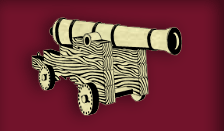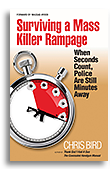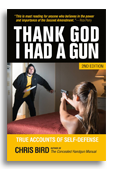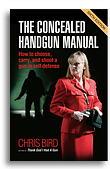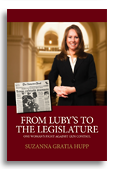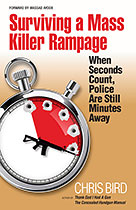Excerpt from Chapter 6
Teachers are taking a three-day course at Tactical Defense Institute in Ohio
Scenarios
After lunch, the same group went back to the school corridor set with the same instructors. This time the teachers wore face-masks and used Airsoft guns, which shoot plastic BBs.
The scenarios included:
- A team from another school has arrived for a basketball game. The teams from both sides are milling about and screaming in the end “room” while being shot by an active killer.
- Students in another room are swarming around while being shot by an active killer.
- In another room students are pointing at the active killer, who has shot twice, stopped, and dropped the gun, and is standing behind it with his hands up.
- A teacher with a gun is teaching in one room when he hears shooting and screaming from another classroom across the hall. He has to decide whether to run to the sound of the shooting or stay and protect his own students.
- An active killer commits suicide; when the teacher arrives, gun in hand, he sees that a student has picked up the gun and is holding it by the barrel.
(Instructor) Forrest Sonewald debriefed each responder after each scenario, he asked them to justify each action they took. Rather than make anybody wrong, he would point out other options the teacher could have chosen. Some of the best lessons came out during his debriefings. These are some of them.
Sonewald: “You swung wide; you got effective hits. She tried to engage you. She shot one person, and you already started to put rounds on her, and she tried to shift fire over. Nice job. Now she’s down, what’s our next concern?”
Responder: “See where the weapon’s at?”
Sonewald: “Okay.”
Responder: “Seeing the condition they are in. Also checking the room, making sure there is no one else in there.”
Sonewald: “Correct. Two percent of the time you’ve got multiple opponents. So we would move up. You have to check the room. You would continue to swing wide, use your space. Try to check as much of the room as possible — soft corners, from out here in the hallway — and if there is another opponent in there, you try to solve your problem from the hallway before you actually enter that room, which is the danger zone.”
“Soft corners” are the corners of the room you can see from outside the room. “Hard corners” are the ones where at least part of your body has to enter the room to see them.
Sonewald went through various options. Do we want to collect that weapon? It depends. One teacher said he would be inclined to take the shooter’s gun. Sonewald asked if covering the shooter from where the teacher had cover was an option. He said, if possible, find another responsible person.
“Get them to stand out in the hallway with their hands up to receive responding law-enforcement officers. A hands-up position is a universal indication you’re not a threat. They need to cut through all the stress and the yelling and screaming to let the law-enforcement responders know that you’re there armed — that you’re a teacher.”
After a scenario in which the active killer was a woman, a teacher asked what he should do if the classroom is empty and there is nobody to cover his back. Should he stay there with his gun drawn covering the shooter?
“That’s going to be a personal decision. If she is shot in the doorway, and the gun clatters away from her, and I can clearly see she’s not moving, I keep my gun in and tight, close to my body. I may move up to secure the weapon, step back, and then again maintain a cover position. If there’s no one there to let responding officers know, again I’m the one in the hallway. Everybody’s screaming, and I have a pistol out. The last thing I want after saving the day is to go from hero to zero, because the first responding officer sees me: maybe there’s supposed to be one person shot in the hallway; there’s blood. He sees me standing there, and he immediately puts a round on me, which is what the officer’s supposed to do. So I may choose to get a nice tight angle, so I’ve got very little area to cover, or move so there’s an open area behind the shooter, in case they do come up and try to do something. And then I’ll holster the weapon. It’s immediately available to me. Important note: that’s why it’s important to work from the holster, so if I need it, I can immediately come out and put additional rounds on the suspect.”
A teacher asked if, after seizing the shooter’s weapon, he would pat them down for more guns. Sonewald responded, “Probably not. My concern is the weapon they have on them. Seventy-five percent of the time they have multiple weapons. We’re talking rifles, shotguns, or multiple pistols. They have them in jacket pockets, pouches, carry bags, or duffel bags. If the person’s down and not moving, my concern is for someone accessing the other firearm. I secure that, so I hold it in a manner that’s probably not a threat [by the barrel].”
In debriefing another teacher, Sonnewald said that, if there are two shooters, they will almost certainly stay together. “When you have two shooters, it’s incredibly dangerous. And the downside is, to date, statistically, the multiple shooters have never separated, so if there is one, the other one is right with them. It’s that mutual-support thing.”
When checking a room, he said, “Swing wide on the doorway to catch all the soft corners. Once you’ve got them checked, then you move up close, and only then you check the hard corners. So now you — or at least part of your body — actually have to enter the room. Once the room is checked, if I know where the bad guy is, I check to see that there’re no other people to direct out. Some people may flee, others may hide under the desk — fight, flight, or freeze.”
One of the scenarios involved the bad guy firing several shots then putting the gun down. When the good gal entered the room, she watched the hands and saw no one holding a gun, but everybody looking and pointing at the shooter.
Sonewald suggested ordering the bad guy to back up and, while holding him at gunpoint, ordering the children to walk out of the room, without getting between him and the bad guy.
“‘You! Lay on the ground.’ Now if he follows your instructions, that’s good. If he doesn’t, that’s a red flag. You want to get him away from the pistol. ‘Back up and lay down, now. Everybody else — you are in the doorway — come out past me to the right.’ Empty the room out. Now the only person in the room is the bad guy, and the gun is on the ground, and you don’t have to go in there.”
He warned the female teacher not to get too close to a bad guy, if he has not been incapacitated. Many criminals have been shot before, and to them it’s no big deal.
(Instructor) Gary Hoff suggested, when getting the guy to back up away from the gun, “one option to consider is: ‘turn around; face away from me.’ That way he can’t see what you are doing, then change position.”
Sonewald also suggested to pass your cell phone to a responsible student, tell them to dial 9-1-1 and hold the phone up to you, while you tell the operator who you are, where you are, and what the situation is.
He said if you have a classroom full of kids, and you hear shooting out in the hallway or in another room, you have to make a decision about whether you stay where you are and protect your kids or do you leave the room and hunt for the shooter — ambush or hunt. All the teachers in the group chose to stay in the room where they were, rather than hunt down the shooter.
Sonewald said the decisions you make when the shooting starts are judgment calls where there are few right or wrong answers.
“You’re going to have to make a decision. I cannot tell you what to do,” he said. “This scenario stuff is the culmination of everything we’ve practiced up to this point — the weapons handling, the use of space, cutting wide on things. You’ve got to make a decision based on individual circumstances — whether or not you enter a room; if you are already in the room, as in some of the scenarios, whether or not you set up an ambush or go hunting for the individual. And there are always the after thoughts — do we secure the firearm, do we direct people out, who do we designate to stay with us with their hands up and say we have an armed teacher covering a downed suspect; or if we don’t have communication, who do we send to the office?”
(Chief Instructor John) Benner added: “Think about this too, folks. If you are involved in a situation, do the best you can. That’s all that anybody can ask.”
Excerpt from Chapter 10
On Tuesday, December 30, 2014, Pastor Terry Howell, sixty-one, had an unpleasant duty to perform: he had to fire his church’s maintenance man.
Howell had started the Living Water Fellowship Church in 2000 in Kissimmee, a suburb on the south side of Orlando. The congregation had grown to about fifteen hundred and included a preschool.
About 8 a.m. Howell was in his office upstairs in the church. He was seated behind his desk with the forty-seven-year-old maintenance man seated across from him. Howell’s daughter Kristy and the church’s administrator, a woman, were also in the room.
Howell started carrying a gun in April 2014. A group, mostly pastors, decided to get concealed-weapons permits. Howell had read accounts of shootings and thought getting a permit might be a good idea.
“Most of the pastors that I know carry, especially in south Florida.”
There was no particular incident that prompted him to get the permit.
“I don’t think that when you get a concealed-weapons permit, even though you might carry a weapon, I don’t think that anyone would ever think they’re going to use it.”
After getting his license he went to the range to practice many times.
That morning Howell was carrying a Springfield XDS semi-automatic in 9mm caliber in a belt holster concealed on his right hip. The maintenance man was legally carrying a .45-caliber semi-automatic, Howell said.
The maintenance man had worked at the church for nine years.
“Probably in the last four, he didn’t really agree with our policies or with me — didn’t like me. But he did a good job, so we can work with that.”
Then the employee got involved in attempting to steal some items from the church, Howell said.
“It all happened within probably three or four minutes. We were just talking about the incident and he’s like: ‘Are you going to fire me over this?’
“And I said: ‘Yes.’
“And at that point, he’s like: ‘F--- you.’
“And he pulls the gun out, aims it at my face, and pulls the trigger. There’s no talking about it; there’s no threatening. He just pulls his gun and fires it.”
Incredibly, the bullet missed, hitting the wall behind Howell, but close enough that the pastor got powder burns causing bleeding on his face. Fortunately, he was wearing glasses, which protected his eyes. The gunman fired twice.
“He fired once at me, and my daughter grabbed his arm and pulled, and he fired the second shot in the side wall.”
Howell credited his daughter with probably saving his life.
“Both of the women thought I was shot. He probably thought I was shot too. I mean, how do you miss that? So they jumped him. They jumped on his back,” the pastor said. “You know in most of these shootings, people just sit there and wait to be picked off. I read somewhere there’s a list of things that you do, and one of them is that you attack the attacker. He can’t shoot everybody. Everybody’s afraid to do anything, so everybody gets shot. And so they jumped him and, of course, I jumped in and grabbed him. They ran out of the room once I had him cornered. Then I don’t remember much. At that point we were out of the inner-office into the bigger part of the office, I’m on the floor. I shoot from the floor.”
Howell was wrestling with his attacker on the floor, then the gunman was up and heading for the door. The pastor was able to get his gun out and fired at him three times, though he remembers firing only twice. He remembers seeing the sights on his gun, at least on the two occasions when he hit his attacker.
|
